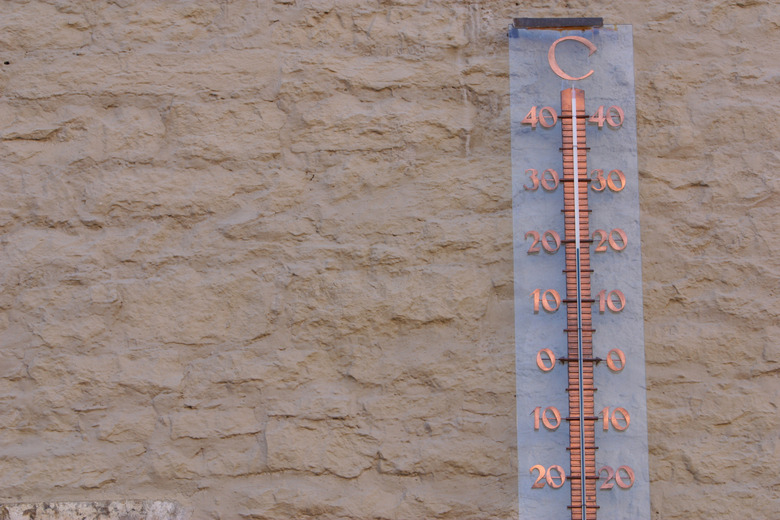Information On Weather Forecasting Instruments
The Earth's atmosphere is unique within the solar system and gives rise to a diverse range of weather phenomena. Forecasting of weather is important, both to peoples everyday lives and to businesses. Meteorologists use a combination of computer modelling and experimental measurements in order to predict the weather. Examples of weather forecasting instruments include the thermometer, barometer, rain gauge and anemometer.
Thermometer
Thermometer
A thermometer is an instrument that is used to measure temperature. The most well-known type of thermometer consists of a glass tube in which liquid mercury is placed. When temperature increases, the volume of mercury increases leading to the level rising. A decrease in temperature leads to a reduction in the volume and a decrease in the mercury level. A scale on the side of the tube allows the temperature to be read. Another type of thermometer, called the spring thermometer, completely fills a glass tube with mercury and a metal diaphragm connected to a spring is placed at the bottom of the tube. As the temperature rises, the pressure upon the diaphragm also rises leading to tension in the spring. The spring then rotates a dial to point to the temperature.
Barometer
Barometer
A barometer is an instrument used to measure pressure which is the force air places upon a surface. There are several different types of barometer. The simplest consists of a tube filled with liquid mercury and sealed on one end. The tube is then inverted and placed in a bowl of liquid mercury. The weight of air pushing down on the bowl is balanced with the weight of the mercury pushing down within the tube. At standard atmospheric conditions this leads the mercury level within the tube to fall to a height of approximately 76 centimeters (29.9 inches). Increases in atmospheric pressure causes the mercury level within the tube to increase in height, while a decrease in atmospheric pressure causes the mercury level within the tube to go down. A more sophisticated instrument for measuring pressure is the aneroid barometer. This consists of a sealed capsule, with flexible sides and mounted in a box. A change in pressure alters the thickness of the capsule. A lever attached to the capsule magnifies these changes, leading a pointer to move upon a scaled dial.
Rain Gauge
Rain Gauge
Rain gauges are used to measure the amount of rainfall that occurs within a fixed amount of time. The simplest type of rain gauge consists of a tube with a scale on it, but these have to be regularly emptied and are therefore no longer used in automated weather stations. One step up from the simple tube consists of a tube on digital weighing scales. The weighing scales are connected to a computer that plots rainfall as a function of time. However, this type of rain gauge also has to have its vessel regularly emptied. A far more elegant solution is the tipping-bucket rain gauge that consists of a funnel connected to a tube that drains into a bucket. The bucket is balanced upon a pivot, such that it tips over when a set volume of water is captured. When this occurs, a second bucket automatically moves into position to catch more rain. Each time a bucket tips, an electronic signal is sent to a data logger which allows the total amount of rainfall to be recorded.
Anemometer
Anemometer
An anemometer is used to measure wind speed. The simplest type of anemometer consists of a tubular axis upon which four arms are placed at 90 degree intervals. Cups are placed upon each of the four arms and as these capture wind, it leads to the rotation of the arms about the tubular axis. A permanent magnet is mounted at the bottom of the axis, and once per rotation it activates a Reed switch, which sends an electronic signal to a computer. The computer calculates the wind speed from the number of turns per minute. A more sophisticated device is the sonic anemometer. This operates by measuring the time taken for a sound pulse to travel between two sensors. The time taken for sound to travel between the sensors depends upon the distance between the sensors, the intrinsic speed of sound in air, and upon the air speed along the sensor axis. Since the distance between the sensors is fixed, and the speed of sound in air is known, the air speed along the sensor axis can be determined.
Cite This Article
MLA
Markings, Samuel. "Information On Weather Forecasting Instruments" sciencing.com, https://www.sciencing.com/information-weather-forecasting-instruments-22256/. 24 April 2017.
APA
Markings, Samuel. (2017, April 24). Information On Weather Forecasting Instruments. sciencing.com. Retrieved from https://www.sciencing.com/information-weather-forecasting-instruments-22256/
Chicago
Markings, Samuel. Information On Weather Forecasting Instruments last modified March 24, 2022. https://www.sciencing.com/information-weather-forecasting-instruments-22256/
